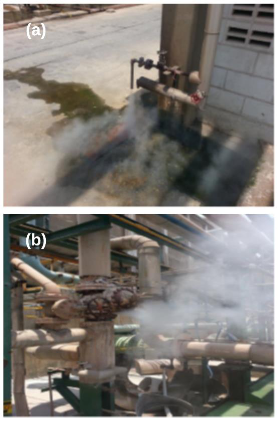Identification of opportunities for energy-productive improvement of an agrochemicals plant
DOI:
https://doi.org/10.22517/23447214.24764Keywords:
Caracterización Energética, Oportunidades de Mejora.Abstract
In order to identify and provide a generalized status, very clear guidelines were developed regarding the activities, techniques, procedures, and tools leading to the establishment, implementation and continuous improvement of the plant's energy consumption management system, which has allowed guiding the organization to a systematic approach to achieve energy performance involving efficiency, safety, use and consumption of energy. The work carried out has allowed the company to identify the savings potentials of the company, in addition to knowing what is the action plan that will allow the company to continuously reduce the cost of energy consumption and the production of greenhouse gas emissions. Finally, a detailed review of the company's current capabilities is carried out, where strengths and weaknesses are identified with a view to the implementation of an Energy Management System based on ISO 50001:2018, an exercise built with the participation of key personnel of the company, in the company of energy managers, finding favorable aspects regarding communication between areas, staff training, management systems and energy planning, among others.
Downloads
References
[2] M. Wegener and G. R. Amin, “Minimizing greenhouse gas emissions using inverse DEA with an application in oil and gas,” Expert Syst. Appl., vol. 122, pp. 369–375, 2019, doi: 10.1016/j.eswa.2018.12.058.
[3] A. Woodward, “Climate change: disruption, risk and opportunity,” Glob. Transitions, 2019, doi: 10.1016/j.glt.2019.02.001.
[4] C. Almer and R. Winkler, “Analyzing the effectiveness of international environmental policies: The case of the Kyoto Protocol,” J. Environ. Econ. Manage., vol. 82, no. December 1997, pp. 125–151, 2017, doi: 10.1016/j.jeem.2016.11.003.
[5] J. Bistline, N. Santen, and D. Young, “The economic geography of variable renewable energy and impacts of trade formulations for renewable mandates,” Renew. Sustain. Energy Rev., vol. 106, no. March 2018, pp. 79–96, 2019, doi: 10.1016/j.rser.2019.02.026.
[6] I. De Courchelle, T. Guérout, G. Da Costa, T. Monteil, and Y. Labit, “Green energy efficient scheduling management,” Simul. Model. Pract. Theory, vol. 93, no. May 2018, pp. 208–232, 2018, doi: 10.1016/j.simpat.2018.09.011.
[7] A. McKane et al., “Predicting the quantifiable impacts of ISO 50001 on climate change mitigation,” Energy Policy, vol. 107, no. May, pp. 278–288, 2017, doi: 10.1016/j.enpol.2017.04.049.
[8] G. A. O. Shuai, L. I. Meng-Yu, D. U. A. N. Mao-Sheng, and W. A. N. G. Can, “International carbon markets under the Paris Agreement: Basic form and development prospects,” Adv. Clim. Chang. Res., 2019, doi: 10.1016/j.accre.2019.03.001.
[9] H. Kanneganti et al., “Specification of energy assessment methodologies to satisfy ISO 50001 energy management standard,” Sustain. Energy Technol. Assessments, vol. 23, no. June, pp. 121–135, 2017, doi: 10.1016/j.seta.2017.09.003.
[10] W. A. Pelser, J. C. Vosloo, and M. J. Mathews, “Results and prospects of applying an ISO 50001 based reporting system on a cement plant,” J. Clean. Prod., vol. 198, pp. 642–653, 2018, doi: 10.1016/j.jclepro.2018.07.071.
[11] “Empresas certificadas - Genio 2.” .
[12] E. Müller, R. Poller, H. Hopf, and M. Krones, “Enabling Energy Management for Planning Energy-efficient Factories,” Procedia CIRP, vol. 7, pp. 622–627, 2013, doi: https://doi.org/10.1016/j.procir.2013.06.043.
[13] ISO, Norma Internacional ISO 50001: Sistema de gestion de la energia - Requisitos con orientacion para su uso, 1st ed. Suiza: ISO, 2011.

Downloads
-
Vistas(Views): 366
- PDF (Español (España)) Descargas(Downloads): 235
- HTML (Español (España)) Descargas(Downloads): 7
Published
How to Cite
Issue
Section
License
Copyright (c) 2023 Scientia et Technica

This work is licensed under a Creative Commons Attribution-NonCommercial-ShareAlike 4.0 International License.
Copyrights
The journal is free open access. The papers are published under the Creative Commons Attribution / Attribution-NonCommercial-NoDerivatives 4.0 International - CC BY-NC-ND 4.0 license. For this reason, the author or authors of a manuscript accepted for publication will yield all the economic rights to the Universidad Tecnológica of Pereira free of charge, taking into account the following:
In the event that the submitted manuscript is accepted for publication, the authors must grant permission to the journal, in unlimited time, to reproduce, to edit, distribute, exhibit and publish anywhere, either by means printed, electronic, databases, repositories, optical discs, Internet or any other required medium. In all cases, the journal preserves the obligation to respect, the moral rights of the authors, contained in article 30 of Law 23 of 1982 of the Government Colombian.
The transferors using ASSIGNMENT OF PATRIMONIAL RIGHTS letter declare that all the material that is part of the article is entirely free of copyright. Therefore, the authors are responsible for any litigation or related claim to intellectual property rights. They exonerate of all responsibility to the Universidad Tecnológica of Pereira (publishing entity) and the Scientia et Technica journal. Likewise, the authors accept that the work presented will be distributed in free open access, safeguarding copyright under the Creative Commons Attribution / Recognition-NonCommercial-NoDerivatives 4.0 International - https://creativecommons.org/licenses/by-nc-nd/4.0/deed.es license.


